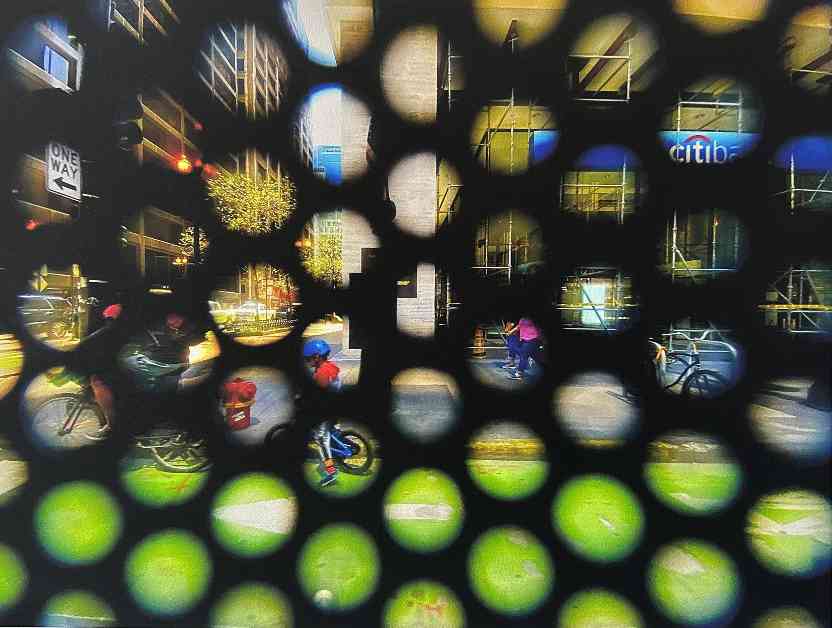In the project 60 wrd/min art critic, writer Lori Waxman explores how art writing can serve an expanded field of artists—including those incarcerated, trying to gain visas, working to establish themselves professionally, or just wanting feedback for a secret hobby. For this iteration, Waxman reviewed work made by Red Line Service artists at a public event held on October 5. Red Line Service brings cultural resources to people with a lived experience of homelessness in order “to expand access to the art world.”
Marcela Adeze Okeke, As Above (2024)Courtesy Red Line Service
Marcela Adeze Okeke
Marcela Adeze Okeke, a self-taught artist and poet, brings a unique perspective to her work, challenging the beauty of nature in her piece As Above (2024). Depicting two men knee-deep in liquid rainbows against the backdrop of a sunset-lit lake, Okeke’s art interrupts and complements nature simultaneously. The figures in the painting evoke a sense of unseen mystery, with their gaze directed in different directions, inviting viewers to ponder the deeper meaning behind their presence in the scene.
Deborah Awwad
Deborah Awwad’s street photography captures the essence of downtown Chicago, showcasing how the city shapes its inhabitants. Through her lens, Awwad reveals the metaphoric transformation of everyday elements, such as a bus window fragmenting a child on a bike or a gleaming metal globe distorting the surrounding skyscrapers. Her images offer a unique perspective on urban life, highlighting the interconnectedness between individuals and their environment.
Abdiel Blanes Góngora
Abdiel Blanes Góngora’s paintings of the Loop in Chicago feature origami cranes as symbolic elements, representing good fortune amidst the urban landscape. By juxtaposing the intricate paper birds against the cityscape, Góngora creates a visual dialogue between nature and architecture. His unique artistic approach challenges traditional representations of urban spaces, inviting viewers to contemplate the intersection of symbolism and reality in art.
Shay Jones
Shay Jones’s maximalist handicrafts celebrate the diversity and complexity of human experience through her Kork Kids and Lotsa Pockets creations. Using recycled materials like wine and champagne bottle tops, Jones crafts whimsical figures and functional aprons that overflow with decorative details. Her art embraces the abundance of life’s elements, from identities to stories, in a joyful and humorous manner that resonates with viewers.
Ravi Arupa
Ravi Arupa’s pencil drawing Space is the Place intricately weaves together outer space and inner space, inviting viewers to contemplate the vastness of the cosmos and the microscopic world simultaneously. Through his meticulous rendering of tiny circles and abstract shapes, Arupa creates a visual tapestry that blurs the boundaries between reality and imagination. His artwork challenges perceptions of scale and perspective, offering a multi-dimensional viewing experience.
Tracey Christmas
Tracey Christmas’s Afro-topographical Explorations tapestry delves into the legacy of redlining in Chicago, highlighting the resilience of communities affected by discriminatory housing practices. Using upcycled yarn, Christmas weaves a narrative of struggle and strength, symbolized by red lines intersecting with vibrant patches of color. Her artwork serves as a visual representation of the impact of systemic racism on urban landscapes, inviting viewers to reflect on the historical context of social inequities.
Red Line Service Printmakers
The Red Line Service Printmakers advocate for the ratification of the UN declaration of housing as a human right through a series of collaborative posters created by artists with lived experience of homelessness. Their powerful graphics combine traditional and digital techniques to convey a direct message of social justice and equality. The print campaign aims to raise awareness of housing rights issues and mobilize support for policy change, emphasizing the importance of art as a tool for activism and advocacy.
Red Line Service Artists
The Red Line Service artists showcase their creativity and skill in glass fusion, producing a diverse range of colorful pendants, magnets, plates, and brooches. Utilizing the technique of joining colored glass in a kiln, these artists explore geometric patterns, lettering, and robotic faces in their creations. Each piece reflects the artist’s unique style and vision, demonstrating the versatility and beauty of glass fusion as an art form. The collaborative effort of the Red Line Service artists highlights the transformative power of art in bringing together individuals from diverse backgrounds to create meaningful and engaging works of art.


